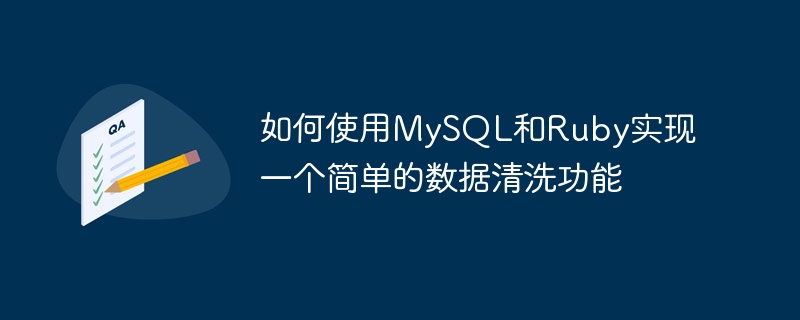

How to use MySQL and Ruby to implement a simple data cleaning function
In the process of data analysis and processing, data cleaning is a very important step. Data cleaning can help us deal with incomplete, inconsistent or erroneous data so that the data can be better analyzed and used. This article will introduce how to use MySQL and Ruby language to implement a simple data cleaning function, and provide specific code examples.
Step 1: Create database and data table
First, we need to create a database in MySQL and create a data table in the database to store our original data and cleaned data .
CREATE DATABASE data_cleaning; USE data_cleaning; CREATE TABLE raw_data ( id INT AUTO_INCREMENT PRIMARY KEY, name VARCHAR(50), age INT, email VARCHAR(50) ); CREATE TABLE clean_data ( id INT AUTO_INCREMENT PRIMARY KEY, name VARCHAR(50), age INT, email VARCHAR(50) );
Step 2: Import original data
Import the original data into the database table. Let's say we have a CSV file called raw_data.csv with the following fields: name, age, and email.
You can use the following code to import the data in the CSV file into the raw_data table:
require 'mysql2'
client = Mysql2::Client.new(:host => "localhost", :username => "root", :password => "password", :database => "data_cleaning")
csv_data = CSV.read('raw_data.csv', headers: true)
csv_data.each do |row|
client.query("INSERT INTO raw_data (name, age, email) VALUES ('#{row['name']}', #{row['age']}, '#{row['email']}')")
end
client.closeStep 3: Data Cleaning
Here, we The original data will be cleaned using Ruby language. For example, we may need to delete duplicate data, delete invalid data, or adjust the data format.
The following code shows how to deduplicate original data:
require 'mysql2' client = Mysql2::Client.new(:host => "localhost", :username => "root", :password => "password", :database => "data_cleaning") client.query( "INSERT INTO clean_data (name, age, email) SELECT DISTINCT name, age, email FROM raw_data" ) client.close
In this example, we use MySQL’s DISTINCT keyword to remove duplicate data . Similarly, we can also use other methods to clean the data, such as deleting records containing invalid data or adjusting the data format.
Step 4: Data Analysis and Export
After cleaning the data, we can further analyze and process the data. Depending on the specific needs, we can use various functions and libraries provided by MySQL and Ruby to operate and analyze data.
Finally, we can use the following code to export the cleaned data to a new CSV file:
require 'mysql2'
require 'csv'
client = Mysql2::Client.new(:host => "localhost", :username => "root", :password => "password", :database => "data_cleaning")
clean_data = client.query("SELECT * FROM clean_data")
CSV.open('clean_data.csv', 'w') do |csv|
csv << clean_data.fields
clean_data.each do |row|
csv << row.values
end
end
client.closeThe above code will export the cleaned data from the clean_data table Retrieve it from and export it to a CSV file named clean_data.csv.
Through the above steps, we can use MySQL and Ruby to implement a simple data cleaning function. According to specific needs, we can modify and extend the above sample code to meet different data cleaning needs. Data cleaning is a crucial step in the data analysis process, which ensures that we use high-quality data for analysis and decision-making.
The above is the detailed content of How to implement a simple data cleaning function using MySQL and Ruby. For more information, please follow other related articles on the PHP Chinese website!




